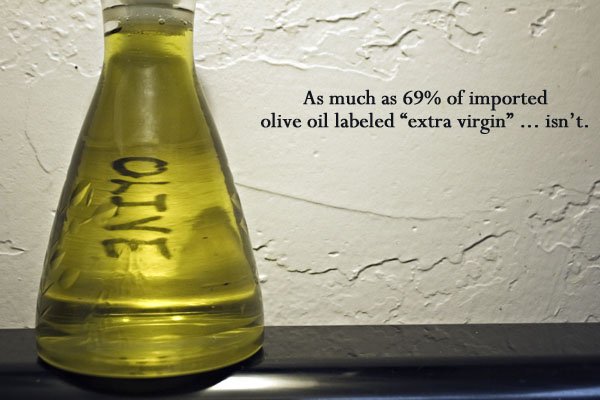The hills of Kalamata, on the southern coast of Greece's Peloponnese peninsula, produce some of the best olives in the world. When pressed, they produce an oil that is almost fluorescent green and sometimes described as "liquid gold."
But after much of that oil is pressed in Greek processing facilities, tanker trucks come to take it straight to the sea. In 2012, 60 percent of Greece's olive oil output was shipped to Italy. There, it is packaged in Italian bottles with Italian labels, and then sent around the world. And most of the profits go back to Italy -- according to consultancy McKinsey, Italy captures an extra 50 percent premium on the price of Greek oil.
Why does this happen? A segment by NPR's Planet Money described some of the issues that two Greek entrepreneurs faced when they tried to export their country's oil.
First, they couldn't find anyone in Greece to make a bottle -- they had to have the bottle made in Italy. They had difficulty getting loans to pay for the bottles, and then they were hit with the taxes. Due to Greece's economic issues, the government asked businesses to estimate and pay the taxes they would owe in 2016 ahead of time -- in 2015.
The story hints at some of the more persistent problems in the Greek economy, besides its high-profile and tragic conflict with its European creditors.
Wherever you stand on Greece and Germany, there's certainly plenty of blame to go around. Greece's European creditors continue to negotiate for austerity measures and oppose forgiving Greece's debts, against the counseling of the International Monetary Fund. Under seemingly endless debt and austerity, Greece's economy has shrunk by about a quarter over the last five years, and unemployment is around 25 percent.
But Greece's economic misery is also, to a certain extent, self-imposed. Beyond Europe, there are many things that Greece might to do to improve its struggling economy by promoting native industry and unwinding onerous restrictions, as James Surowiecki recently argued in the New Yorker.
Many segments of the economy are excessively regulated: A Surowiecki points out, bakeries can only sell bread in a few standardized weights. Other red tape prevents people from starting new businesses and foreigners from investing in Greece from abroad.
The fact that Greece holds only a 28 percent share of the global market for "Greek Feta cheese" and 30 percent of U.S. market for "Greek-style yogurt" also shows a clear commercial opportunity, McKinsey said in its report.
Greece's agricultural sector has a lot of potential. Greece is the third largest olive oil producer worldwide, and is nearly on par with Italy, which is number two after Spain. In fact, Costco changed the source of its Kirkland brand olive oil from Italy to Greece earlier this year after a disease ravaged the Italian crop.
Olive oil alone represents nearly a tenth of Greece's agricultural output, according to Eurostat. Greece also exports honey, wine, fruit and vegetables around the world, and could do much more. Beyond agriculture, some of Greece's most promising sectors are generic pharmaceuticals, aquaculture, elder care, cargo and logistics transport, waste management and tourism, says McKinsey. Tourism alone accounted for over 17 percent of Greece's economy in 2014. Yet, as Surowiecki points out, most tourists in Greece are Greek rather than foreigners, suggesting a huge opportunity.

Tourists visit the Parthenon temple on the Acropolis hill, in downtown Athens on July 8, 2015. ANDREAS SOLARO/AFP/Getty
What would Greece need to take advantage of these opportunities? Financial stability, for one. The credit freeze earlier this year has made life for Greece's food industries even more difficult, freezing imports of necessary farm inputs like fertilizers, pesticides and fuel. Beyond that, Greece needs infrastructure, including larger and more modern production and packaging facilities to take advantage of its agricultural capacity, says McKinsey.
Easier regulation could also help Greek businesses compete internationally. Nearly half of all Greek manufacturers have fewer than 50 employees, Surowiecki says, suggesting that manufacturing is nowhere near economies of scale. And Greece's agricultural units are almost five times smaller than the E.U. average, according to McKinsey.
With a debt at 175 percent of its economy and unemployment approaching 30 percent, things will continue to be tragic for the Greeks. But even in Greece's economic troubles, there are big opportunities.

Ana Swanson is a reporter for Wonkblog specializing in business, economics, data visualization and China. She also works on Know More, Wonkblog's social media channel.




